We must be in the South Issue #13 11-29-2017
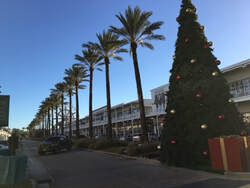
Sweetie, honey or ma'am.
I have been called all 3 in the most musical southern drawl by everyone from grocery store clerks to the dock hands at marinas. It sounds wonderful.
And as soon as I start talking I have seen heads pop up and look at me.
I guess I’m the one with an accent around here.
I have been called all 3 in the most musical southern drawl by everyone from grocery store clerks to the dock hands at marinas. It sounds wonderful.
And as soon as I start talking I have seen heads pop up and look at me.
I guess I’m the one with an accent around here.
You are from WHERE?
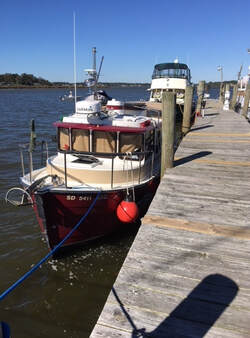
On the back of our boat you can see our boat’s name and our home port. Nellie May, Lake Madison, South Dakota. That has been the start of some fun conversations.
-Is South Dakota by Canada? (no, that’s North Dakota)
-How the heck did you get on the river system from there? (we put the boat on a trailer for 600 miles before we put her in the river)
-Aren’t you cold? Tim gets that a lot when he is wearing a t-shirt and shorts while the locals are in parkas.
-Is South Dakota by Canada? (no, that’s North Dakota)
-How the heck did you get on the river system from there? (we put the boat on a trailer for 600 miles before we put her in the river)
-Aren’t you cold? Tim gets that a lot when he is wearing a t-shirt and shorts while the locals are in parkas.
How big is your boat?
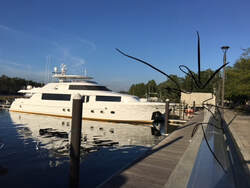
How big is that boat?
What they really mean is how SMALL is that boat?
We have the smallest boat doing the Loop.
Most of the boats are yachts at least 40-50 feet. They have 2 bedrooms and 2 bathrooms. And a full kitchen with an oven.
Our boat is 25 foot and more like camping than cruising. But it has a bathroom with a door so I’m a happy girl.
What they really mean is how SMALL is that boat?
We have the smallest boat doing the Loop.
Most of the boats are yachts at least 40-50 feet. They have 2 bedrooms and 2 bathrooms. And a full kitchen with an oven.
Our boat is 25 foot and more like camping than cruising. But it has a bathroom with a door so I’m a happy girl.
Where are you going?
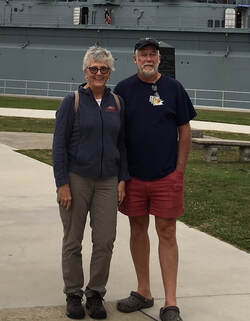
Where are you going? We say near Chicago and get some really strange looks.
Then they tell us we are headed in the wrong direction.
So, we explain The Great Loop. Start near Chicago, spend a year on the rivers and end back where we started.
Which usually leads to the next comment---
-You must really like each other.
We have traveled 1803 river miles over the last 2 1/2 months.
We tell them, so far-so good.
Then they tell us we are headed in the wrong direction.
So, we explain The Great Loop. Start near Chicago, spend a year on the rivers and end back where we started.
Which usually leads to the next comment---
-You must really like each other.
We have traveled 1803 river miles over the last 2 1/2 months.
We tell them, so far-so good.
Locks on the river Issue #12 11-19-2017
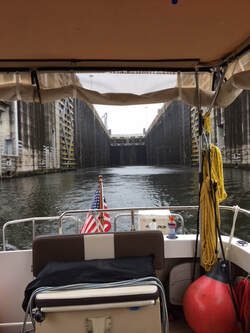
A lock is like a huge bathtub with huge gates on each end. It is a device used for raising and lowering boats, ships and other watercraft between stretches of water of different levels on river and canal waterways.
We have gone through 30 locks in the 1735 miles we have traveled so far. By the time we finish the Loop we will gone through over 100 locks.
Each lock has a lockmaster. “Locking through” starts with Tim calling the lockmaster on the VHF radio telling them the name of our boat, whether we are upbound or down bound on the river and requesting a lock through. Since we are in the South we have to listen very carefully to the instructions because the lockmasters all seem to have a very Southern drawl. And it’s sort of a no-no to say “WHAT?”
We have gone through 30 locks in the 1735 miles we have traveled so far. By the time we finish the Loop we will gone through over 100 locks.
Each lock has a lockmaster. “Locking through” starts with Tim calling the lockmaster on the VHF radio telling them the name of our boat, whether we are upbound or down bound on the river and requesting a lock through. Since we are in the South we have to listen very carefully to the instructions because the lockmasters all seem to have a very Southern drawl. And it’s sort of a no-no to say “WHAT?”
Lockmasters run the show
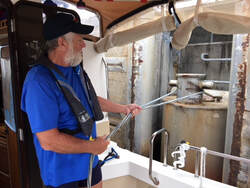
The lockmaster will tell us how long the wait will be, which side he’d like us to tie to in the lock and to please wear your PFD while in the lock. These guys have been great. And they all call Tim “Captain”. As in, “Come right on in Cap when you see the green light and tie to either side. Let me know when you are secure.”
They open the gates, we idle in at no-wake speed, pick a floating bollard (a big hook thing that goes up and down with the water) and I lasso it with my trusty line. (You have lines on boats, not ropes…) We radio we are secure, they close the gates and then we either go up or down as they equalize to the level of the water on the other side of the lock.
When this is complete we stay tied to the bollard until the gates open, the lockmaster blows a loud blast on his locomotive-sounding horn. Then we cast off, motor out of the lock, call the lock master to tell him we are clear of the lock, thank him for his service and wish him a good day. This whole process can take anywhere from 30 minutes to hours.
Click here to see a short video
At Wilson Lock we waited 8 hours before we were allowed to enter the lock at 3AM. It wasn’t any fun at all. Commercial shipping has priority.
They open the gates, we idle in at no-wake speed, pick a floating bollard (a big hook thing that goes up and down with the water) and I lasso it with my trusty line. (You have lines on boats, not ropes…) We radio we are secure, they close the gates and then we either go up or down as they equalize to the level of the water on the other side of the lock.
When this is complete we stay tied to the bollard until the gates open, the lockmaster blows a loud blast on his locomotive-sounding horn. Then we cast off, motor out of the lock, call the lock master to tell him we are clear of the lock, thank him for his service and wish him a good day. This whole process can take anywhere from 30 minutes to hours.
Click here to see a short video
At Wilson Lock we waited 8 hours before we were allowed to enter the lock at 3AM. It wasn’t any fun at all. Commercial shipping has priority.
We got this!
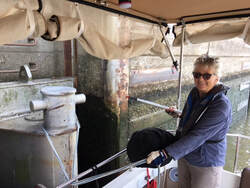
The Wilson Lock has a drop/lift of 90 feet. All we could think of was the gates in Jurassic Park.
Many of the locks have a drop/lift of 30 feet or so.
Some of the locks were terrifying because they were so old they didn’t have anything to tie to. Lock 53 on the Ohio River was in such bad shape we used both of our boat hooks to grab a busted, rotten ladder on side of the wall.
And one lock wasn’t even operating. The gates were open and we motored through. Sounds easy, right? Not so much. It was like a tunnel with rapids. We were doing fine until the big boat ahead of us slowed down. Then we were dealing his huge wake AND his wake reflecting off the sides of the cement lock.
Since I couldn’t help at all I just covered my eyes.
We got through and I didn’t cry or throw up.
I called it a winner.
Many of the locks have a drop/lift of 30 feet or so.
Some of the locks were terrifying because they were so old they didn’t have anything to tie to. Lock 53 on the Ohio River was in such bad shape we used both of our boat hooks to grab a busted, rotten ladder on side of the wall.
And one lock wasn’t even operating. The gates were open and we motored through. Sounds easy, right? Not so much. It was like a tunnel with rapids. We were doing fine until the big boat ahead of us slowed down. Then we were dealing his huge wake AND his wake reflecting off the sides of the cement lock.
Since I couldn’t help at all I just covered my eyes.
We got through and I didn’t cry or throw up.
I called it a winner.
Shiloh Battlefield, Tennessee Issue #11 11-12-2017
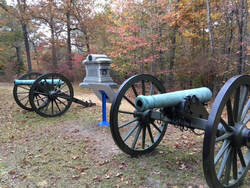
While we were staying at Florence Marina in Florence Alabama we rented a car and drove to the Shiloh National Military Park. The battlefield tour started with a 32-minute video to introduce the battle and the impact it had on the outcome of the Civil War.
We were given a map that highlights the troop movements of the armies before and during the two-day battle.
We were given a map that highlights the troop movements of the armies before and during the two-day battle.
2 Day Battle
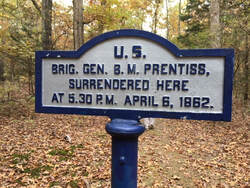
Shiloh Battle lasted just 2 days.
April 6, 1862 starting at 4:55 am and ending April 7 at 5:30 pm. The total number of casualties was 23,746.
Absolutely staggering.
You will notice on this sign that the time of the surrender is 5:30 pm. As we followed the map in our car to the 20 separate stops highlighting troop movements we were amazed at the precise recording of the time and location of each event, battle or troop movement.
The explanation is this battlefield Park was established and marked by men who actually participated in the battle, on both sides. After the Civil War this area was declared a Military Park in the 1890’s.
April 6, 1862 starting at 4:55 am and ending April 7 at 5:30 pm. The total number of casualties was 23,746.
Absolutely staggering.
You will notice on this sign that the time of the surrender is 5:30 pm. As we followed the map in our car to the 20 separate stops highlighting troop movements we were amazed at the precise recording of the time and location of each event, battle or troop movement.
The explanation is this battlefield Park was established and marked by men who actually participated in the battle, on both sides. After the Civil War this area was declared a Military Park in the 1890’s.
Defeated Victory Monument
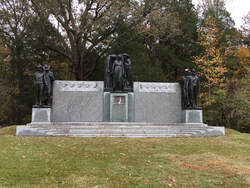
This monument, designed and sculptured by Frederick C. Hibbard, was erected in 1917 by the United Daughters of the Confederacy in memory of all Southern troops who fought in the battle.
In the center of the massive pedestal is carved the bust of Gen. Albert Sidney Johnston, the Confederate commander who was killed during the afternoon of the first day.
At the extreme right, the figure in front represents the Confederate infantryman who has snatched up his flag in defiance of the Northern army. The figure to his rear is the artilleryman, who is calm as he appears to gaze through the smoke of battle.
To the left, the figure in front represents the cavalryman. His hand is spread, indicating frustration. He is eager to help, but cannot penetrate the heavy undergrowth. The figure back of the cavalryman represents the officers of the Confederate army. He has his head bowed in submission to the order to cease firing when, it seemed, had it not been given the first day, there might have been a Confederate victory.
The central group represents a "Defeated Victory." The front figure, representing the Confederacy, is surrendering the laurel wreath of victory to Death, on the left, and Night, on the right. Death came to their commander and Night brought reinforcements to the enemy, and the battle was lost.
The panel of heads on the right represents the spirit of the first day. How hopefully and fearlessly the 11 young Confederates rushed into battle! The panel of heads on the left represents the second day of the battle and the sorrow of the men, now reduced to 10, over the victory so nearly won and so unexpectedly lost.
In the center of the massive pedestal is carved the bust of Gen. Albert Sidney Johnston, the Confederate commander who was killed during the afternoon of the first day.
At the extreme right, the figure in front represents the Confederate infantryman who has snatched up his flag in defiance of the Northern army. The figure to his rear is the artilleryman, who is calm as he appears to gaze through the smoke of battle.
To the left, the figure in front represents the cavalryman. His hand is spread, indicating frustration. He is eager to help, but cannot penetrate the heavy undergrowth. The figure back of the cavalryman represents the officers of the Confederate army. He has his head bowed in submission to the order to cease firing when, it seemed, had it not been given the first day, there might have been a Confederate victory.
The central group represents a "Defeated Victory." The front figure, representing the Confederacy, is surrendering the laurel wreath of victory to Death, on the left, and Night, on the right. Death came to their commander and Night brought reinforcements to the enemy, and the battle was lost.
The panel of heads on the right represents the spirit of the first day. How hopefully and fearlessly the 11 young Confederates rushed into battle! The panel of heads on the left represents the second day of the battle and the sorrow of the men, now reduced to 10, over the victory so nearly won and so unexpectedly lost.
Shiloh Meeting House
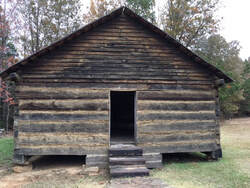
This is the Shiloh Meeting House, the log Methodist church that gave the battle its name.
The original building was destroyed so this building was built using trees from the area and using tools that would have been used to build the original church.
The original building was destroyed so this building was built using trees from the area and using tools that would have been used to build the original church.
Hallowed Ground
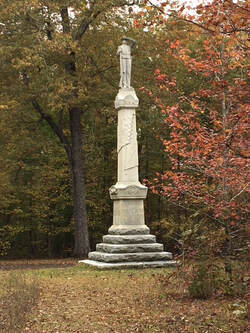
As we followed the map the battle came alive to us. It was sobering. This is hallowed ground and you can feel it. The countryside probably looks the same as it did in 1862.
The trees and rolling hills are still there. But we could imagine the sounds of the fighting and the smoke from all the cannons in this small patch of land.
We agreed we are very glad we went but it was a sobering visit.
The trees and rolling hills are still there. But we could imagine the sounds of the fighting and the smoke from all the cannons in this small patch of land.
We agreed we are very glad we went but it was a sobering visit.
Chattanooga, Tennesee
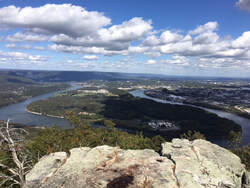
We traveled from Joe Wheeler State Park to Chattanooga last week. Do you see how the river twists and turns in this photo? At some points we could look through the trees and actually SEE the river on the other side. I told Tim the tugboat was too heavy to portage. Don't know what that means? It means if the tugboat were a canoe we would have pulled up on the shore, carried our stuff overland to the river and then went back and carried the canoe. Sort of a short-cut.
Tim's all about short cuts.
But we didn't. The scenery was beautiful.
Tim's all about short cuts.
But we didn't. The scenery was beautiful.
Tennessee Aquarium

The Tennessee Aquarium has one building called The Ocean and one called The River. Jellyfish? Ocean!
We spent the entire day looking at all the exhibits. I like the jellyfish because the room was dark and quiet. Sort of zen-like.
We spent the entire day looking at all the exhibits. I like the jellyfish because the room was dark and quiet. Sort of zen-like.
Tim liked the LIVE presentation.
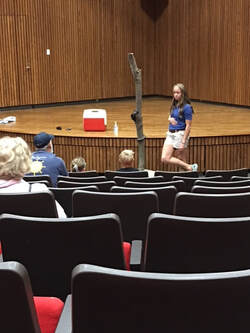
We wandered into a Presentation in the River part of the Aquarium and THEN found out it was about rat snakes. I immediately relocated to the back row of the theater. I know my limits. I didn't want to do my "snake dance" in front of all those people.
You will notice Tim is in the front row with the other kids.
The snake is climbing up the tree.
I'm still creeped out.
You will notice Tim is in the front row with the other kids.
The snake is climbing up the tree.
I'm still creeped out.
From the top of Lookout Mountain
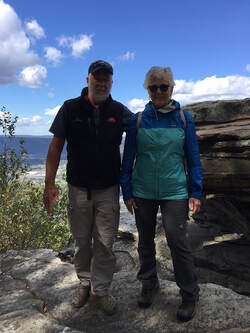
We rode the Incline Railway to the top of Lookout Mountain. We learned all about the Battle for Chattanooga and other Civil War battles. It was impressive to see the actual location of the fighting including the cannons used in the battle.
The Battle for Chattanooga was a turning point in the Civil War. We watched a movie at the visitor center before we walked around the Chattanooga National Military park. It was sobering to realize how many men were killed on that mountain.
13,824 total estimated casualties in 3 days.
November 23-25, 1863.
Hallowed ground.
The Battle for Chattanooga was a turning point in the Civil War. We watched a movie at the visitor center before we walked around the Chattanooga National Military park. It was sobering to realize how many men were killed on that mountain.
13,824 total estimated casualties in 3 days.
November 23-25, 1863.
Hallowed ground.